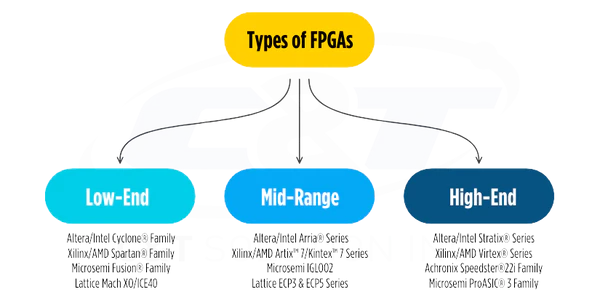Choosing a mid- to high-end FPGA (Field-Programmable Gate Array) involves evaluating several factors based on your application requirements, budget, and long-term project goals. Mid- and high-end FPGAs generally offer greater logic resources, higher performance, more flexible I/O options, and additional features compared to low-end devices. Below is a step-by-step guide to selecting an FPGA in this category:

1. Understand Your Application Requirements
The first step is to define your application requirements. Mid- and high-end FPGAs typically target different industries such as communications, automotive, defense, industrial control, and signal processing. The main aspects to consider include:
- Performance (Speed): Do you need high-speed processing, fast clock speeds, or large data bandwidth? FPGAs vary in clock frequencies (e.g., 500 MHz to 1 GHz+).
- Complexity (Logic resources): Do you require a large number of logic gates, flip-flops, DSP slices, and memory resources? Complex designs (e.g., video processing, machine learning) require more resources.
- I/O capabilities: How many high-speed I/O pins (e.g., PCIe, Ethernet, DDR) and interfaces (e.g., LVDS, HDMI) do you need?
- Power consumption: High-performance FPGAs consume more power, so evaluate the power constraints for your project.
- Special features: Do you need built-in hardware accelerators (e.g., for cryptography, AI inference), high-speed transceivers, or soft processors (e.g., ARM cores)?
2. Evaluate the FPGA Family
FPGA manufacturers offer families of devices designed to meet different requirements. Some popular families include:
3. Key Parameters to Compare
Logic Resources (Logic Cells/Look-Up Tables - LUTs):
- High-end FPGAs have millions of LUTs and flip-flops, allowing for large, complex designs.
- Mid-range FPGAs may have hundreds of thousands of LUTs, which should suffice for most moderate applications.
DSP Blocks:
- For applications involving digital signal processing (e.g., audio/video processing, wireless communications), check the number of DSP slices available.
- High-end FPGAs have more DSP slices for high-performance math operations (e.g., filtering, FFT).
Memory Blocks (BRAM, DDR) and High-Speed I/O:
- High-end FPGAs provide extensive block RAM, including support for high-speed external memory (e.g., DDR4).
- Consider the number of memory interfaces and whether the FPGA supports multi-bank, high-bandwidth memory for your application.
Transceivers and High-Speed Interfaces:
- If your application requires high-speed communication (e.g., PCIe, 100G Ethernet, optical transceivers), ensure that the FPGA supports the required number of high-speed transceivers and interfaces.
- Mid-range FPGAs generally support up to 10 Gbps, while high-end devices can handle 100 Gbps and above.
Embedded Processors:
- Many high-end FPGAs come with embedded ARM cores (e.g., ARM Cortex-A53, R5) for system-on-chip (SoC) applications.
- Some also have hard processors for real-time tasks, which might be useful for complex applications such as control systems or image processing.
4. Development Tools and Ecosystem
- Xilinx (AMD):
- Vivado is the primary development environment, which is feature-rich but can have a steeper learning curve.
- Xilinx also provides Vitis for AI/ML application acceleration.
- Intel (Altera):
- Quartus Prime is the development environment for Intel FPGAs, offering a range of tools for hardware design and software development.
- Platform Designer helps with creating complex systems by integrating various components.
- Other Ecosystems:
- Check if the FPGA family has a mature ecosystem for your specific domain (e.g., 5G, AI, automotive) that includes pre-built IP cores, reference designs, and support for external peripherals.
5. Cost and Power Consumption
- High-end FPGAs are generally more expensive and power-hungry. If cost is a concern, consider whether the performance benefits justify the extra cost and power consumption.
- If your application doesn’t require the highest performance, a mid-range FPGA might be more cost-effective and still provide ample resources for your design.
6. Future Scalability
- Consider the long-term needs of your application. If you expect to scale your design or move to a more demanding version later, choosing a high-end FPGA might offer future-proofing.
- Some families (like Xilinx Zynq Ultrascale+ or Intel Agilex) provide scalability within their series, allowing you to move to higher models as needs grow.
7. Reliability, Support, and Availability
- Evaluate the support and availability of the FPGA. Some FPGAs are used in industries like aerospace and automotive, where reliability and support are critical.
- Look for an FPGA with robust documentation, community support, and a long lifecycle for future updates.
8. Prototyping and Evaluation Kits
- Many FPGA manufacturers offer evaluation boards for prototyping, which come with reference designs and a user-friendly environment to test your concepts. It's a good idea to check whether the FPGA family you're considering has easy access to prototyping kits.
Example of FPGA Selection:
- Xilinx Kintex UltraScale (KCU): Suitable for mid-range applications like machine learning acceleration, 5G base stations, video processing, etc.
- Intel Stratix 10: For high-performance applications in areas like data centers, high-frequency trading, or advanced communications systems.
- Xilinx Virtex UltraScale+: For top-end applications requiring massive parallel processing and high-speed I/O (e.g., radar, high-end computing).
- Intel Arria 10: A good choice for applications like video/image processing, high-speed data acquisition, and communications.
By following these steps, you should be able to select a mid- to high-end FPGA that balances performance, cost, and power consumption based on your specific requirements.
